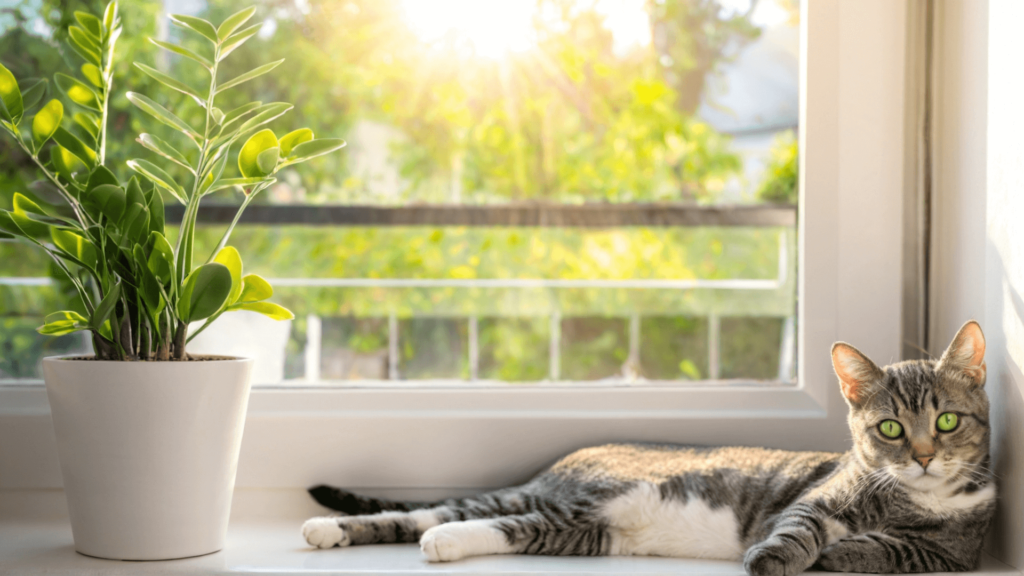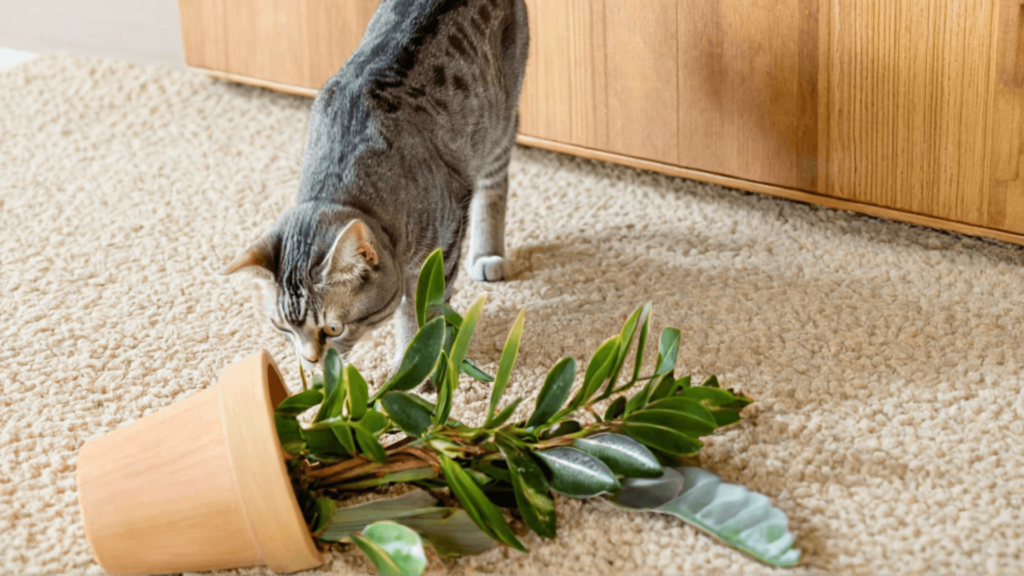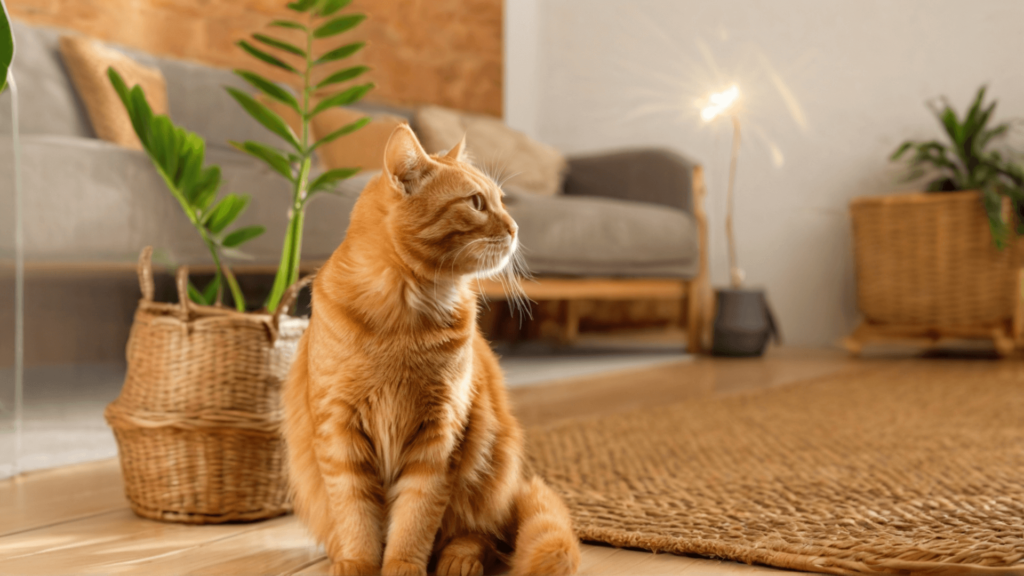Have you ever found yourself worrying about your furry friend while admiring the lush, vibrant greenery of your home? Many pet owners love the elegant appeal of the ZZ plant, but if you’re a cat owner, concerns might arise when you hear that ZZ Plant Toxic to Cats. In this article, you’ll discover everything you need to know—from identifying warning signs to practical steps for ensuring a safe home environment for your beloved pet.
By the end of this guide, you’ll be armed with actionable steps, expert advice, and even a fun DIY treat recipe to help comfort your pet if stress levels run high. Let’s dive in and ensure your home remains both stylish and secure.
Table of Contents
Introduction: What You Need to Know About ZZ Plant Toxic to Cats

The ZZ plant has become a popular choice among indoor gardeners due to its low maintenance and modern aesthetic. However, while it may seem like the perfect plant to brighten up your living space, there’s a darker side to its beauty—especially if you have cats. Many pet owners wonder: Is your favorite indoor greenery a silent threat?
Why This Guide Matters to You
- Your Pet’s Safety: As a responsible pet owner, you want to provide a safe environment for your cat. Understanding the risks associated with the ZZ plant is essential for preventing accidental poisoning.
- Conflicting Information: You may have come across terms like “zz plant toxic to dogs” or “zz plant toxic to cats aspca” online. This article will help clarify these concerns with verified information.
- Actionable Advice: From recognizing zz plant poison symptoms to creating a pet-safe space, you’ll learn exactly what to do if you suspect any exposure.
In the following sections, we will walk you through the three key steps: recognizing the warning signs, preventing exposure, and taking immediate actions if your cat is at risk.
Step 1: Recognize the Warning Signs and zz Plant Poison Symptoms

Understanding the symptoms is the first line of defense. When your cat encounters a toxic plant, early detection of zz plant poison symptoms can make all the difference.
Identifying zz Plant Poison Symptoms
Cats are naturally curious creatures, but that curiosity can sometimes lead them into harm’s way. If you notice any unusual behavior or physical signs in your cat, consider the following symptoms:
- Excessive Drooling: A clear sign that something isn’t right.
- Vomiting: Repeated vomiting can indicate ingestion of a toxic substance.
- Lethargy: If your cat seems unusually tired or weak, it might be struggling to recover.
- Difficulty Breathing: Labored breathing or wheezing should be taken very seriously.
These symptoms may occur quickly after exposure. It’s essential to remember that not every cat will react the same way, so always monitor your pet closely if you suspect they’ve come into contact with a ZZ plant.
When to Be Concerned
Even if your cat exhibits only mild symptoms, it’s important to err on the side of caution. Here’s what you should do if you observe any signs:
- Immediate Action: If you suspect your cat has ingested any part of a ZZ plant, remove the plant from the vicinity immediately.
- Consult a Veterinarian: Do not wait for symptoms to worsen. Contact your vet or a local emergency animal clinic right away.
- Monitor Closely: Keep an eye on your cat’s behavior over the next few hours. Even if symptoms seem to improve, a follow-up visit to the vet is a wise precaution.
Remember, these symptoms aren’t just limited to ZZ Plant Toxic to Cats; they can also overlap with reactions seen in cases like “are zz plants toxic to cats” and similar scenarios.
Step 2: Preventing Exposure & Ensuring Safe ZZ Plant Handling

Prevention is always better than cure. With a few adjustments to your home environment and careful handling, you can continue to enjoy your ZZ plant while keeping your cat safe.
Creating a Cat-Safe Home Environment
You don’t have to remove the ZZ plant from your home altogether, but you do need to be proactive. Consider these practical steps to minimize the risk of exposure:
- Placement:
- Place your ZZ plant on a high shelf or in a room where your cat does not usually roam.
- Use hanging planters to keep the plant out of reach.
- Barriers:
- Consider using pet gates or barriers if the plant must be in a commonly accessed area.
- Ensure that window sills or tabletops where you might place the plant are not easily accessible to your curious cat.
- Education:
- Teach family members, especially children, about the risks and proper handling of the plant.
- Regularly remind everyone in your home that the plant is beautiful but can be dangerous if not treated carefully.
Incorporate the concept of “zz plant poisonous to touch” by ensuring that any direct handling of the plant (especially when cleaning or repotting) is done with gloves, so you don’t inadvertently transfer any toxins.
ZZ Plant Care and Maintenance
Proper ZZ plant care not only enhances the plant’s beauty but also reduces the risk of accidental poisoning. Here are some essential care tips:
- Light Requirements:
- ZZ plants thrive in low to moderate light. Too much direct sunlight can cause the leaves to yellow, an indicator that the plant is under stress.
- Ensure that your plant is in a spot with consistent, indirect light.
- Watering Routine:
- Water the plant sparingly. Overwatering can lead to root rot, while under-watering might stress the plant and cause leaf drop.
- Typically, watering once every week or two is sufficient, but always check the soil moisture first.
- Propagation Tips:
- If you wish to propagate your ZZ plant, use clean tools and follow careful instructions to avoid any potential toxin exposure.
- When propagating, ensure that any cuttings are kept away from your cat until they are firmly rooted.
- Additional Considerations:
- Keep an eye on common issues like “zz plant yellow leaves” or any signs of pest infestations.
- If you own a “raven zz plant” or “variegated zz plant,” note that these variants may have slight differences in care, but the toxicity risks remain similar.
By following these guidelines, you not only improve the longevity and health of your ZZ plant but also create a safer environment for your pet.
Step 3: Immediate Actions if Exposure Occurs
Despite all precautions, accidents can happen. Knowing exactly what to do if your cat is exposed to a ZZ plant can save valuable time and protect your pet’s health.
Is ZZ Plant Toxic to Cats? What to Do Now
If you notice that your cat has chewed on or ingested part of a ZZ plant, act quickly:
- Remove the Plant:
- Immediately relocate the plant to a secure location where your cat cannot reach it again.
- Rinse Your Cat (if Safe):
- If you feel confident and it is safe to do so, gently rinse your cat’s fur around the mouth with water.
- Avoid using any soaps or chemicals that might worsen the situation.
- Contact a Veterinarian:
- Time is critical. Call your veterinarian or an emergency animal clinic immediately for advice.
- Provide them with details about the exposure, including the amount ingested and any observed symptoms.
- Follow Professional Advice:
- Your vet may instruct you to bring your cat in for examination or advise you on home care if the symptoms appear mild.
Contact Information & Trusted Resources
- Local Poison Control: Have the number of your local animal poison control hotline handy.
- Veterinary Emergency Contacts: Save the contact information of the nearest emergency animal hospital in your phone.
- Trusted Resources: For reliable information, refer to organizations like the ASPCA. Look up “zz plant toxic to cats aspca” online for additional guidelines.
Quick and decisive action can make all the difference if your cat is at risk. Always err on the side of caution and do not hesitate to seek professional help.
DIY Cat-Friendly Treat Recipe for a Healthy, Safe Environment
In stressful situations, comforting your pet with a little treat can help soothe their anxiety. Here’s a simple, vet-approved recipe to make your cat feel a bit better while you manage the situation.
Cat-Friendly Treat Recipe Table
Below is a table outlining a straightforward treat recipe that’s designed to be both nutritious and safe. Always consult your vet before introducing new foods into your pet’s diet.
| Ingredient | Quantity | Notes |
|---|---|---|
| Canned Salmon | 1/4 cup | Rich in omega-3 for coat health |
| Pumpkin Puree | 2 tablespoons | Aids digestion; ensure unsweetened |
| Catnip (dried) | 1/2 teaspoon | Encourages relaxation |
| Oat Flour | 2 tablespoons | Binds ingredients; ensure gluten-free |
How to Prepare the Treats
- Mix Ingredients:
- In a small bowl, combine the canned salmon and pumpkin puree.
- Stir in the dried catnip and oat flour until you achieve a uniform mixture.
- Shape into Bites:
- Use your hands or a small spoon to form bite-sized treats.
- Place the treats on a parchment-lined tray.
- Bake Lightly:
- Preheat your oven to 350°F (175°C) and bake for 8-10 minutes.
- Allow the treats to cool before serving to your cat.
This recipe not only provides your pet with a healthy snack but also helps to distract them from any stress caused by exposure incidents. Treat time can be a small moment of joy in an otherwise anxious situation.
Frequently Asked Questions (FAQ) About ZZ Plant Toxic to Cats
Below are some of the most common questions we receive from pet owners concerned about the safety of their indoor greenery.
Q1: What are the main symptoms if my cat ingests a ZZ plant?
- A: Look out for drooling, vomiting, lethargy, and difficulty breathing. These zz plant poison symptoms indicate that your pet may be experiencing a toxic reaction. Even mild symptoms should prompt a consultation with your vet.
Q2: Are there differences between ZZ plant toxicity in cats and dogs?
- A: Yes, while both cats and dogs can experience adverse effects, the severity and specific symptoms may vary. For instance, zz plant toxic to dogs might manifest differently, but it’s crucial to treat both cases with the utmost urgency. Always refer to guidelines like “zz plant toxic to cats aspca” for species-specific advice.
Q3: How can I safely care for my ZZ plant without endangering my pet?
- A: Follow proper ZZ plant care guidelines:
- Place the plant out of reach.
- Use pet-friendly cleaning methods.
- Monitor your cat’s behavior around the plant.
- Consult reliable sources to learn more about “is a zz plant toxic to cats.”
- Regularly check for issues like “zz plant yellow leaves” which can indicate plant stress.
Q4: Where can I find reliable information on ZZ plant toxicity?
- A: Trusted sources such as the ASPCA, veterinary websites, and well-established gardening blogs offer verified information on whether ZZ Plant Toxic to Cats and other related concerns. Always cross-reference details with professional advice.
Conclusion
In wrapping up, your commitment to keeping your home both beautiful and safe is commendable. The risks associated with ZZ Plant Toxic to Cats might seem overwhelming at first, but by following these three simple steps, you can protect your pet and maintain a stylish space:
- Recognize the Warning Signs: Stay vigilant for any zz plant poison symptoms in your cat, such as drooling, vomiting, or lethargy.
- Prevent Exposure: Create a cat-safe environment by placing your ZZ plant out of reach and adopting proper ZZ plant care techniques.
- Take Immediate Action: If exposure occurs, act quickly by removing the plant, rinsing your cat (if safe), and seeking veterinary help immediately.
Your pet’s safety is paramount. By taking proactive measures and staying informed, you ensure that your cat remains happy, healthy, and secure while you continue enjoying the many benefits of your beautiful indoor plants.
Your Next Steps
- Review Your Space: Take a moment today to assess your home environment. Are there any plants, including your ZZ-plant, that might be within your pet’s reach?
- Implement the Changes: Rearrange your space to create safe zones for your cat, and consider using barriers if needed.
- Share the Knowledge: If you found this guide helpful, pass it on to other pet owners who might benefit from this information.
- Stay Connected: Subscribe to trusted newsletters or join local pet owner groups to keep updated on the latest safety tips and recommendations.
By being informed and proactive, you’re taking a major step toward safeguarding your pet’s well-being. Remember, every precaution counts when it comes to protecting those you love most.
Final Thoughts
Caring for your pet goes beyond daily feeding and grooming—it’s about creating an environment where every element, even your cherished ZZ-plant, contributes to their overall happiness and safety. If you ever feel unsure or need further advice, don’t hesitate to consult with a veterinarian or a trusted plant care expert.
Taking a moment now to reassess your home setup and plant placement can prevent future heartache. Your vigilance today is an investment in your pet’s tomorrow.
Thank you for reading this comprehensive guide on ZZ Plant Toxic to Cats. Your dedication to learning and acting on these tips shows just how much you care about your furry friend. Now, go ahead and create a safer, healthier space for both you and your cat—and feel free to share your experience or ask further questions in the comments section below.
Remember, a safe home is a happy home, and you have the power to make all the difference in your pet’s life. Stay informed, act quickly, and keep those tails wagging!
By following this detailed guide, you are well-equipped to handle any situation related to ZZ Plant Toxic to Cats. Whether it’s recognizing symptoms, preventing potential hazards, or taking immediate action, each step you take builds towards a safer environment for your beloved pet. Enjoy your indoor gardening while keeping your furry friend secure and comfortable.

